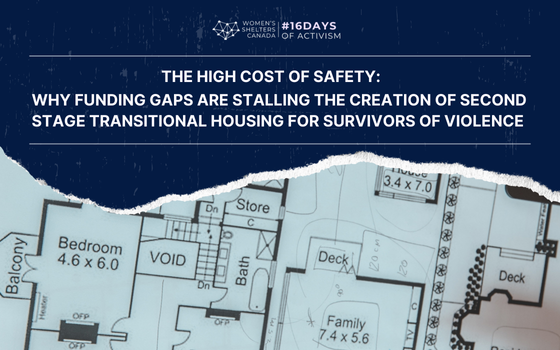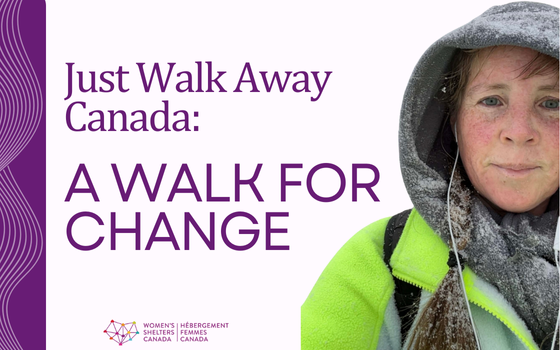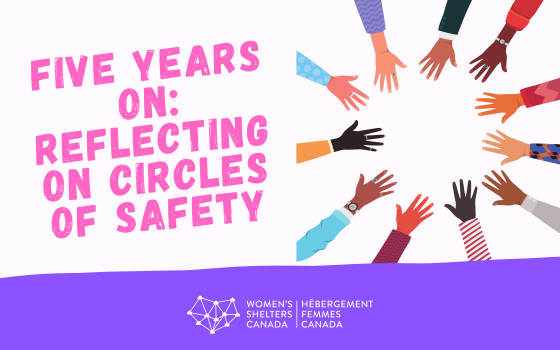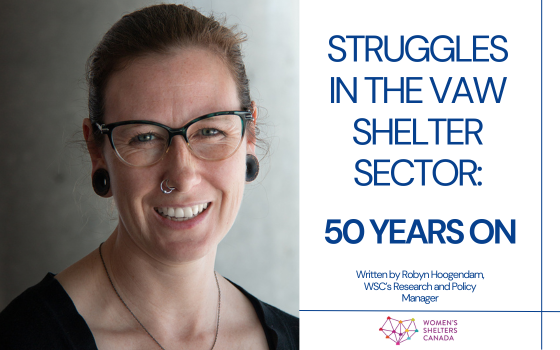
Krys Maki
In September 2020, Women’s Shelters Canada (WSC) released a ground-breaking report on second stage shelters entitled, Breaking the Cycle of Abuse and Closing the Housing Gap: Second Stage Shelters in Canada. Nominated for the Canada Community-Based Research award that year, the report examines the importance of second stage shelters on the spectrum of supports available to survivors who have experienced domestic violence across the country.
Almost two years later, WSC is launching a large-scale project based on the recommendations of this study. Made largely possible by a $2 million grant from the Slaight Family Foundation, the four-year project will see WSC support VAW shelters in the development of up to 16 new second stage shelters across Canada.
At the forefront of this second stage initiative is Research and Policy Manager, Krys Maki, who has been leading WSC’s work on second stage shelters. WSC Communications Coordinator, Jed Nabwangu, had the pleasure of sitting down with Krys to talk about this new project.
Jed Nabwangu: Can you describe the nature of the second stage shelter project that the $2M grant from the Slaight Family Foundation will support?
Krys Maki: This $2M grant will facilitate the creation of second stage shelters across the country with the specific purpose of reducing the barriers many of these shelters face.
From our research, we know that many VAW shelters are interested in creating second stage shelters, but often the process to do so is complicated and requires a lot of resources and housing expertise that our sector simply doesn’t have right now. This project is meant to ensure that different shelters across the country can access the federal funding and resources that are currently available through the co-investment fund at the Canada Mortgage and Housing Corporation (CMHC).
We will also be hiring a second stage shelter program manager to oversee this project and to ensure that those who want to go forward will be supported.
JN: Why is this program so important?
KM: In 2017, the National Housing Strategy (NHS) committed 25% of its overall budget towards women and children fleeing violence via its co-investment fund. Yet anecdotally and through the limited data provided by the government, we know that VAW shelters are not able to access these funds due to their complex and bureaucratic nature.
Part of the development of this project is to reduce such barriers and ensure that people can get through this process so that up to 16 second stage shelters can be built in areas of high need. It’s also a way to hold the government accountable for promising funds that are not easily accessible while simultaneously addressing a huge gap in their ability to support our sector.
JN: Why do shelters need this project to start second stage housing initiatives?
KM: The original NHS co-investment fund application was made up of several stipulations that rendered it inaccessible. For example, shelters needed to provide 5-25% capital upfront as well as a breakdown of capital and operational co-funding, proof of land acquisition, approved zoning, and approval from another level of government. In other words, they had to have the entire project ready to go and be shovel ready.
We know that our sector is particularly pushed to the limit and the capacity to do this work is just not there. There’s also the reality of competition with the private sector and developers who have the resources to put together a great application that meets all the criteria.
Yet it’s equally discouraging and important to note that even when shelters do tick all the boxes, they are still met with resistance. For example, in one case a shelter we had contact with let us know that they had been able to complete their application in full, only to then be met with a barrier when CMHC representatives claimed they didn’t understand the design needs for second stage shelters (e.g. safety planning, communal spaces, trauma informed structures, etc.).
We were happy to see the changes with CMHC’s new initiative for women’s shelters and transition houses (fall 2021-spring 2022). CMHC approached us in the fall of 2021 with news that they were launching $250 million co-investment funding for VAW shelters for new builds and repairs. Building on our recommendations from our reports, they shared how they were reducing barriers in the application process and recognizing the specific needs of VAW shelter spaces and design. We’ve been working closely with their senior management team during the rollout and to ensure that VAW expertise is at the table. In February WSC led a VAW 101 training session with their underwriters to provide context of the challenges facing our sector as well as the importance of VAW and trauma informed expertise.
JN: Why is second stage housing essential for women and children fleeing violence? How does it merge the gap between the emergency shelter and permanent housing?
KM: Second stage shelters were developed out of a need that emergency shelters saw when many women either had to return to abusers or face homelessness due to a lack of safe and affordable housing options. Second stage is important in the continuum of supports for survivors of violence because we know that when a woman tries to leave an abusive situation, it’s the most dangerous time for her. Emergency shelters are temporary, so they don’t provide much time to seek longer-term solutions, such as applying for social assistance or looking for housing.
For many women, second stage is a life saver that provides tangible support to rebuild and take the necessary time to heal. Though some folks don’t need it and are ready to reintegrate after emergency shelter stay, for others, it a critical aspect of breaking the cycle of violence and preventing homelessness.
JN: Will this project impact the current lack of shelters in rural and remote areas?
KM: Yes, we will be doing specific outreach to rural, remote, and northern communities that face disparity in accessing resources as well as regions where there is currently no provincial government funding in place for second stage shelters, such as Ontario, Saskatchewan, and Newfoundland and Labrador.
JN: Can you give a snapshot of what development will look like over the four years of this program?
KM: The first year will be dedicated to setting the foundation of the program by getting folks informed through outreach and recruitment, as well as hiring our second stage shelter program manager.
The whole idea is for the program to be a hands-on support that assists shelters applying for the co-investment funds and to provide upfront funding to start meeting with experts and conducting housing market research. Our manager will be working closely with them throughout their application processes.
The process will be different for everyone as every community has its own set of unique needs that create different timelines, challenges, and strengths, the latter of which will be at the basis of our approach.
_______
For more information on WSC’s second stage shelter program, check back on our website over the next few months and/or never miss an update by signing up to our e-newsletter here.
This interview has been edited for length and clarity.






Leave A Comment
You must be logged in to post a comment.